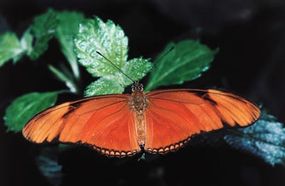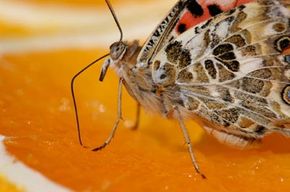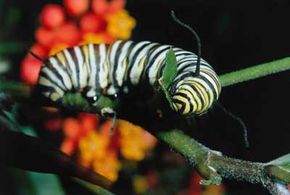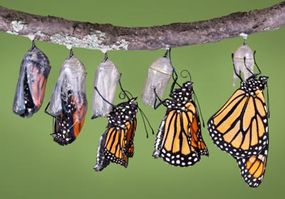Quck answer
Butterflies have a complex life cycle that starts with an egg, hatches into a caterpillar, undergoes metamorphosis into a chrysalis, and finally emerges as a butterfly. They have a unique wing structure that enables them to fly and navigate long distances. Butterflies use their antennae to sense the environment, while their proboscis allows them to feed on nectar and other liquids. They also have a sophisticated visual system, including color vision and polarized light sensitivity, that helps them find mates and locate food sources. Additionally, butterflies play an important role in pollination and serve as indicators of environmental health.
Wild Animals

A butterfly perches on a leaf in the Ecuadorian Amazon rainforest.
Photo by Jeff Foott, В© Discovery Communications, LLC
The lives of butterflies revolve around flying. Their vibrant wings are the largest and most noticeable parts of their bodies, and they spend a lot of time in the air. Flying uses up a lot of energy, so butterflies consume nectar from flowers, which they need to fly to. Even when they rest, they keep their wing muscles warm to prepare for flight.
Butterflies do not fly just for fun, and their colorful wings are not just for display; they all relate to reproduction in some way. Butterflies use their wing colors to blend in with their surroundings and to warn predators, which helps them survive long enough to reproduce. They also use wing shape and color to identify and sometimes impress a mate.
For many butterflies, finding a mate and reproducing are the last events in their lives. Most only live long enough to begin a new generation of butterflies. Some species live long enough to migrate for thousands of miles or hibernate through the winter. However, at the end of their journey or the beginning of spring, the actions of the butterflies remain the same. They mate, the females lay eggs, and all the adults die. The eggs hatch into caterpillars, which eventually transform into similarly short-lived butterflies.
In this article, we will explore the lives of butterflies from the moment they emerge from their chrysalis and gradually dry their wings. We will start by examining butterfly anatomy, including how they use their feet to find food and why their wings are transparent, not colorful. We will also investigate some of the unexpected food sources for butterflies and whether these fluttering insects may be facing extinction.
Butterfly Anatomy: Wings and Scales

Butterfly anatomy
Lee Dempsey, 2008 HowStuffWorks
A butterfly begins its life as a caterpillar, which hatches from an egg, eats voraciously, and eventually sheds its skin to reveal a chrysalis. The chrysalis is a protective shell in which the caterpillar transforms into a butterfly. By the time the butterfly emerges, or ecloses, it looks very different from when it first formed the chrysalis. Although it still has a head, thorax, and abdomen, it has undergone a significant transformation.
Many of a butterfly’s sensory organs, in addition to its proboscis, a long, straw-like tube used for drinking, are located on its head. These include:
The butterfly has various sensory organs such as compound eyes that can detect color and movement, antennae that can detect smells and the butterfly’s direction, and labial palps that help to determine food. The butterfly’s legs also have taste organs that help in finding food. The wings are the most prominent feature of a butterfly, made of an ultra-thin, transparent material called chitin and adorned with layers of tiny scales that provide insulation and protect them. The butterfly has to expand and dry its wings as soon as it emerges from the chrysalis and prepare for its life of flight. Cleaning all its sensory organs, transforming its proboscis into a drinking tube, and getting rid of waste are some of the things that the butterfly has to do before it even takes flight. The butterfly’s order is called Lepidoptera, which means “scale winged.”
Butterfly Kinesiology: Staying Warm and Flying High

Owl butterflies have large eyespots on their wings to scare off predators, and their undersides blend in with woody textures.
Photo by Jeff Foott, В© Discovery Communications, LLC
The survival of a butterfly depends heavily on weather conditions. Strong winds and raindrops can harm their delicate wings, and with no way to fix them, butterflies tend to seek shelter when they sense changes in the weather. However, temperature can pose an even greater threat than precipitation.
Butterflies’ bodies function best at an internal temperature of around 82 degrees Fahrenheit (28 degrees Celsius). If they get too cold, their wing muscles stop functioning, and they cannot search for food or escape from predators. Many butterfly species use the colors on their wings to warn predators of their chemical defenses or startle them with vivid, eye-like designs before flying away. However, in very cold weather, they are unable to do so.
Unlike mammals that can regulate their body temperature in most conditions, butterflies must use their surroundings to manage their body heat. Keeping warm during the day can be a challenging task. Butterflies bask in the sun with their wings open to absorb warmth, use their wings as reflectors to focus sunlight on their thorax, or rest on warm rocks to soak up heat from underneath. When the weather is too warm, butterflies fold their wings flat and position themselves to expose the narrow edge of their wings to the sun.

A Julia butterfly rests on the island of Trinidad with its wings open.
Photo by Jeff Foott, В© Discovery Communications, LLC
Butterflies can also warm up their muscles by moving their wings in tiny increments, similar to how the human body shivers in cold weather to generate heat. Even in the air, butterflies’ bodies get colder as cool breezes pass over them, causing them to fly in short, quick bursts on chilly days. Butterfly migration involves more than 200 species of butterflies, with the monarch butterfly being the most renowned. They travel long distances to overwintering grounds in California and Mexico in several stages, involving multiple generations of butterflies.
The Names of Butterfly Wings
Butterflies are often named after the shape, color, pattern, or way they fly. For example, swallowtails have tail-shaped wings, metalmarks have metal-colored spots on their wings, and skippers are named for their darting flight.
Butterfly Behavior: Eating and Puddling

Butterflies feed on nectar, which is a reward for pollinators. While some butterflies help spread pollen, others take the nectar without assisting in pollination, making them parasitic. Although the proboscis is adapted for consuming nectar, butterflies also need other nutrients and minerals for flying and reproduction. Some butterflies consume fruit or drink from shallow water sources to obtain these nutrients. This behavior is called puddling. Butterflies also need minerals and salt, which they obtain from urine, dung, and standing water. To supplement their diet, people can make a nectar feeder by mixing sugar and water and placing it in a dish with a brightly colored sponge.
Butterflies’ ultimate goal is to reproduce. Learn more about their mating rituals and how male butterflies help females lay eggs.
Butterfly Reproduction

A monarch butterfly feasts on a milkweed plant.
Photo credit: Jeff Foott, В© Discovery Communications, LLC
A butterfly’s life cycle is divided into four stages which include egg, larva, pupa, and adult. The egg is usually found attached to the underside of a leaf, and after hatching, it transforms into a caterpillar. The caterpillar’s main job is to consume sufficient food to prepare for its metamorphosis into a butterfly. This change occurs during the pupal stage when the butterfly rests inside its chrysalis. The adult butterfly emerges from the chrysalis, and its primary purpose is to mate.
Butterflies reproduce just like other animals, with male sperm fertilizing female eggs. Males and females of the same species recognize each other by the size, color, shape, and vein structure of their wings, all of which are species-specific. Butterflies also identify each other through pheromones, or scents. During mating, males use clasping organs on their abdomens to hold onto females.
Many male butterflies deliver more than just sperm to their mates. Most offer a spermatophore, which is a bundle of sperm and nutrients that a female requires to produce and lay eggs. Some males gather specific nutrients to create a better spermatophore to attract a mate. In some species, though, females do not have a choice. In these cases, males mate with females before they leave their chrysalis or swarm the chrysalis, waiting for females to emerge. In most species, males and females look similar, but females frequently have larger abdomens for carrying their eggs.

This composite image depicts a monarch butterfly emerging from its chrysalis and spreading and drying its wings.
В© Cathy Keifer/iStockphoto
Females store sperm in a sac called a bursa until they are ready to lay their eggs. They fertilize their eggs while laying them, using the last sperm they received first. For this reason, males from some species deposit a substance on the female’s abdomen that dries into a film to prevent her from mating with other males. Females lay their eggs one at a time or in groups of hundreds, depending on their species.
A butterfly must take extra care when laying eggs. The eggs must be kept warm and at the correct humidity level. If there is too much moisture, the egg will decay or be attacked by fungus. If there is too little moisture, the egg will dry out. Because caterpillars must begin feeding as soon as they hatch, the female usually lays the eggs directly on the type of plant the caterpillar will eat. Eggs typically attach to the underside of leaves, making them difficult for predators to spot. A few butterfly species use a predator’s nests, such as anthills, as protection and disguise their eggs with the same pheromones that predators use to recognize each other.
Despite all the effort that female butterflies put in to protect their eggs, very few of them survive to adulthood. Ants, birds, and other animals can eat the eggs, while caterpillars and butterflies are a popular snack for everything from birds to bats. Some insects also hide in or around flowers to prey on adult butterflies. A butterfly’s chrysalis has few defenses against predators, and at all stages of life, a butterfly can succumb to fungi and diseases.
Parasitic wasps pose a threat to butterflies by laying their eggs in the caterpillars, causing their death and feeding on their bodies. The future of butterflies is in danger due to habitat loss, human hunting, and pesticides. The monarch butterfly population is threatened by illegal logging in the protected Butterfly Biosphere Reserve where they overwinter. Urbanization and development also destroy the plants where caterpillars eat and butterflies lay their eggs. Some butterfly species are highly prized by collectors, leading to over-collecting and a decline in their population. Pesticides are another major threat to butterflies, and natural forms of pest control are recommended to encourage their presence in yards and gardens. While butterflies can be cared for in greenhouses and other indoor locations, habitat loss and pesticide use will continue to be a threat to their survival.
FAQ on Butterfly Anatomy
What is the butterfly’s life cycle?
A butterfly goes through four stages: egg, larva, pupa, and adult. This process is called metamorphosis.
What is the name of the butterfly’s tongue?
A butterfly’s tongue is called a proboscis, which is a tube-shaped organ that uncoils to feed and recoils when not in use.
What is the lifespan of a butterfly?
Butterflies have a short lifespan of up to 14 days.
Do all butterflies have six legs?
Most butterflies have six legs, but those in the Nymphalidae family only have four legs.
What are the three main parts of a butterfly’s body?
The head, thorax, and abdomen are the butterfly’s three main body parts that contribute to its growth and health.
Additional Information
Related Articles on HowStuffWorks
- How Butterfly Gardens Work
- Where do butterflies get their striking colors?
- How Caterpillars Work
- Will a butterfly die if I touch its wing?
- What’s the difference between moths and butterflies?
- How can you train honeybees to sniff for bombs?
- How do honeybees make honey?
- How Fleas Work
- How Bees Work
- How Chiggers Work
- How Ticks Work
- How Cicadas Work
- How Spiders Work
- How Allergies Work
- How Alligators Work
- How Bats Work
- How Dogs Work
- How Evolution Works
- How Mosquitoes Work
- How Sharks Work
- How Snakes Work
- How Whales Work
More Useful Links
- eNature Field Guides: Lepidoptera
- Tree of Life: Lepidoptera
- Butterflies and Moths of North America
- BugGuide: Order Lepidoptera
- Animal Diversity Web: Lepidoptera
Sources
- Ajilvsgi, Geyata. “Butterfly Gardening for the South.” Taylor Trade Publishing. 1991.
- Chen, Jian-Hua, et al. “X-ray Tomography and Chemical Imaging within Butterfly Wing Scales.” Synchrotron Radiation Instrumentation: Ninth International Conference. American Institute of Physics. 2007.
- Cizek, Lukas et al. “Host Plant Defenses and Voltinism in European Butterflies.” Ecological Entomology. Vo. 31. 2006.
- Meyer, John R. “Lepidoptera.” N.C. State University. 3/8/2005 (3/16/2008) http://www.cals.ncsu.edu/course/ent425/compendium/butter~1.html
- Molleman, Freerk et al. “Food Intake of Fruit-feeding Butterflies: Evidence for Adaptive Variation in Proboscis Morphology.” Biological Journal of the Linnean Society. Vol. 86. 2005.
- Murphy, Dennis D. “Butterflies and their Nectar Plants: The Role of the Checkerspot Butterfly Euphydryas editha as a Pollen Vector.” Oikos. Vol. 43, no. 1. 1984.
- Peggy Notebaert Nature Museum. “The Butterfly Lab.” 3/18/2008 http://www.chias.org/online/thebutterflylab/anatomy/internalorgans.html#reproductive
- Rusterholz, Hans-Peter, et al. “Can Nectar Properties Explain Sex-specific Flower Preferences in the Adonis Blue Butterfly Lysandra bellargus?” Ecological Entomology. Vol. 25. 2000.
- Schappert, Phillip J. “A World for Butterflies.” Firefly Books. 2000.
- Wahlberg, Niklas. “That Awkward Age for Butterflies: Insights from the Age of the Butterfly Subfamily.” Systemic Biology. Vol. 55, no. 5. 2006.
- Wilcott, Elizabeth. “Insect Physiology.” University of Arizona. 1/12/2003 (3/16/2008) http://research.biology.arizona.edu/mosquito/willott/507/anatomy/manduca/ManAll.html
FAQ
1. What are butterflies?
Butterflies are insects that belong to the order Lepidoptera. They are known for their beautiful wings, which are covered in scales that give them their vibrant colors. Butterflies go through a process of metamorphosis, starting as eggs and then developing into caterpillars, pupae, and finally, adult butterflies.
2. How do butterflies fly?
Butterflies fly by using their wings, which are made up of two layers of thin, membranous material. They beat their wings in a figure-eight motion to generate lift and propel themselves forward. Butterflies are also able to adjust the angle and shape of their wings to control their flight.
3. What do butterflies eat?
Butterflies feed on nectar from flowers, which provides them with the necessary carbohydrates for energy. Some species of butterflies also feed on tree sap, rotting fruit, or even animal dung. As caterpillars, they eat leaves of specific plants depending on their species.
4. How do butterflies reproduce?
Butterflies reproduce sexually, with males and females mating to produce offspring. Males typically locate females by sight and smell, and then engage in a courtship display to attract them. Females lay their eggs on specific types of plants, which will serve as food for the caterpillars when they hatch.
5. How long do butterflies live?
The lifespan of a butterfly varies depending on the species, with some living only a few days and others living up to a year. The average lifespan of a butterfly is typically around two weeks.
6. What predators do butterflies have?
Butterflies have many predators, including birds, spiders, and other insects. They have evolved a number of defense mechanisms, such as camouflage and toxic chemicals, to protect themselves from being eaten.
7. How do butterflies navigate?
Butterflies navigate using a combination of visual cues and an internal compass. They are able to detect the position of the sun and use it as a reference point, as well as recognize landmarks and other visual cues in their environment.
8. Why are butterflies important?
Butterflies play an important role in pollinating plants, which is crucial for the health of ecosystems. They also serve as indicators of the health of the environment, as they are sensitive to changes in climate and habitat. Additionally, butterflies are a source of beauty and wonder for people all over the world.





Leave a Reply